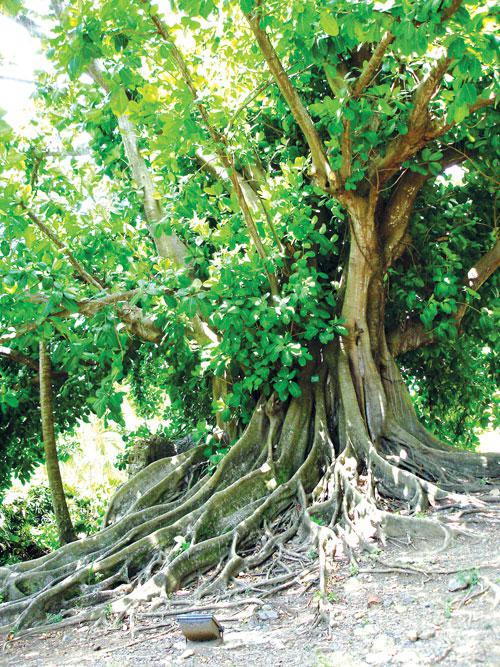Figs for all tastes – Phuket Gardening

PHUKET: One of the stranger aspects of attempting an alphabetical survey of plants is that you end up with some odd bedfellows. Take the letter “F” for example. It embraces the huge genus of figs or ficus to give the family its botanical appellation.
In Plant Materials in Thailand, no fewer than 24 different varieties are listed; they dominate the letter in much the same way that the so-called strangler fig throttles its unfortunate host.
Figs vary from majestic park and forest trees in warmer climes to tough indoor plants such as the rubber tree, or the edible fig of Mediterranean landscapes. There is even a creeping fig which ventures no more than an inch or two above the ground.
F religiosa is at once the most revered, the most unusual and, some would say, the most pernicious of trees. Revered because Buddhism avers that the Lord Gautama attained enlightenment while meditating beneath its ample shade for six years, the bodhi tree flourishes on temple grounds everywhere in Thailand. In Hindu mythology it is associated with fertility in women. But it is definitely not one for your conventional garden. Fast growing and deciduous, it can attain thirty meters, possesses a trunk up to three meters wide and has hanging roots that may occupy much of the surrounding area.
The Bodhi tree is bizarre in another respect. It needs, as nearly all figs do, the presence of a pollinating agaonid or fig wasp which lays its eggs within the growing fruit. The larvae feed on the internal gall flowers, crawl out as adults, and in the process cross-pollinate the external flowers. The mature fruits and seeds (not palatable to humans), are in turn eaten by birds, and dispersed as droppings, where they often lodge in the forks or bark of a host tree and develop into seedlings. In time, these intruders will send roots down to the ground which will, in time, completely envelop and destroy the tree. Hence the pejorative name of “strangler fig”.
Nonetheless, no self-respecting Buddhist or Hindu would ever dream of cutting down a tree which has not only sacred associations, but has been used for centuries for its medicinal properties, treating everything from gout and gastric disorders to diabetes. Moreover, it is an impressive ornamental presence and not just on account of its massive size and longevity, but because of its attractive, glossy, heart shaped foliage.
Benghalensis is a related species with similar aerial roots, but is capable of spreading much more widely. One celebrated banyan tree, in Calcutta, has a spread of 400 feet and covers more than three acres. The broad, stiff leaves are a shiny deep green and the fruits ripen to orange.
More suitable for our Thai gardens is Ficus carica, known world-wide as the edible fig, and a dominant feature of Mediterranean countries. It is not as popular as it deserves to be in Thailand for the simple reason that it dislikes the high and continuous humidity – a feature of life here – which in F. carica tends to promote mildew. Oddly, edible figs grow best on poorish soil; too much nitrogen promotes leaf growth at the expense of the succulent, pear-shaped fruit. Pruning during the period of dormancy will increase the tree’s fruiting capacity.
As befits a commercially viable fruit, there are many cultivars: “Black Genoa” is a prolific yielder of sweet, dark red flesh, “Mission” has blackish fruits. “White Adriatic” should do better here: it has pale greenish brown figs with tasty pink flesh. This was the variety that I grew in the mountains of Southern Spain. It loved the cool nights and cropped heavily and reliably.
If you are lucky enough to lay your hands on a fig tree, don’t plant it close to a wall: it has a large root system and the tap root may go down several meters. One reason why they seem unaffected by drought.
Tip of the week – More on pollination
Some plants have male (stamens) and female parts (pistil) on different parts of the same plant. So an agency will again be needed to transfer the pollen. Most melons, pumpkins, and squash, for example, have both male and female flowers. Commercial growers sometimes activate the fertilization process by using a fine brush to transfer pollen from one flower to another. But again,insects are the main distributors.
A few species, for example, some citrus varieties, do not require pollination at all, though tangerines do. Obviously as a grower or gardener, it is important that you know the requirements of the species.
Another factor is maturity. Some trees do not bear fruit until a certain age; for avocadoes this is about six years, for papayas, rose apples, guavas or bananas as little as 18 months. Jujubes and jack fruit take 2-3 years.
If you have a question, or a garden that you would like featured, you can email Patrick Campbell here.
Keep checking our online Phuket Lifestyle pages, follow us on Twitter @phuketgazette or join our Facebook fan page for regular gardening features and tips.
— Patrick Cambell
Latest Thailand News
Follow The Thaiger on Google News:


























